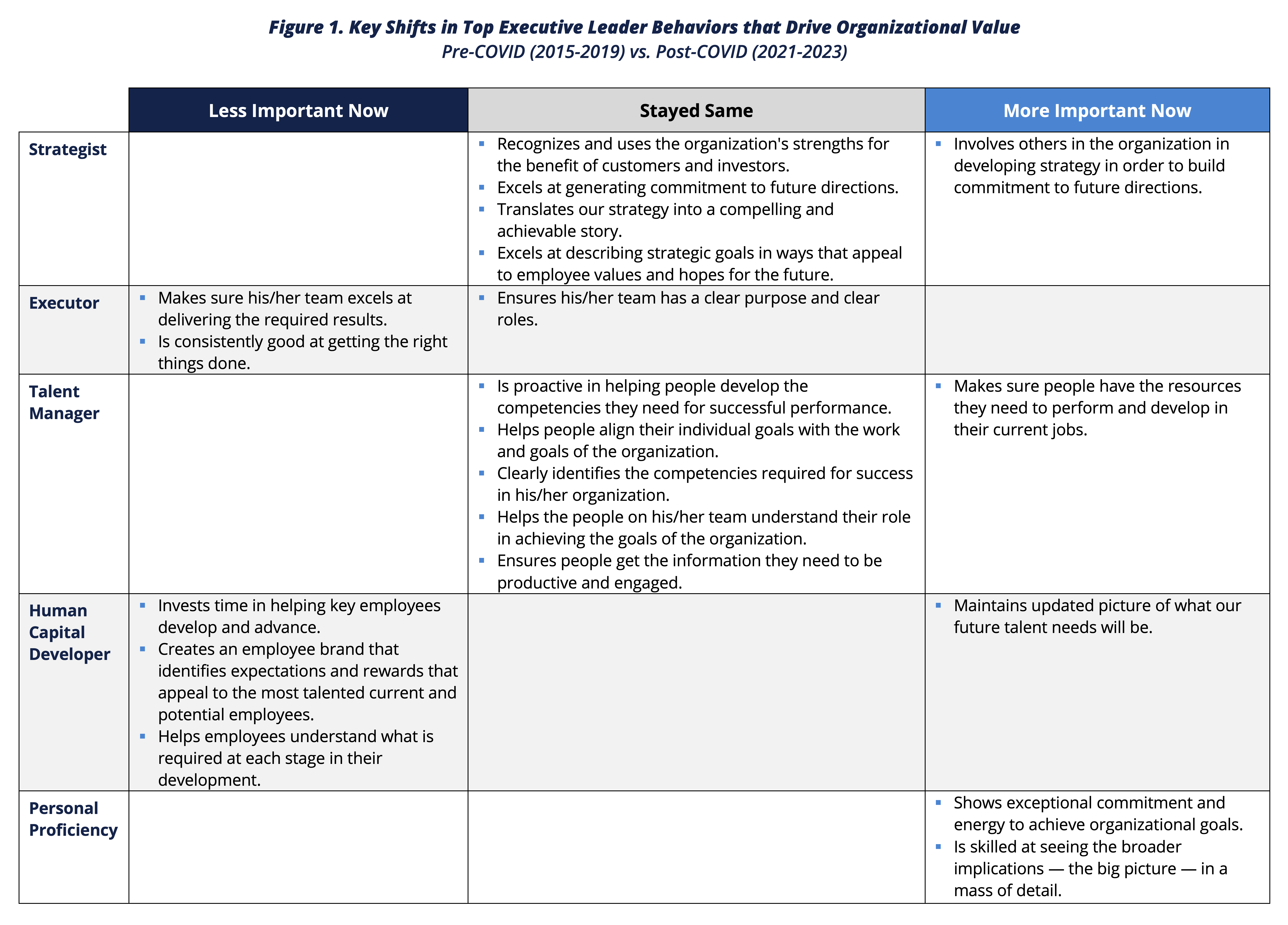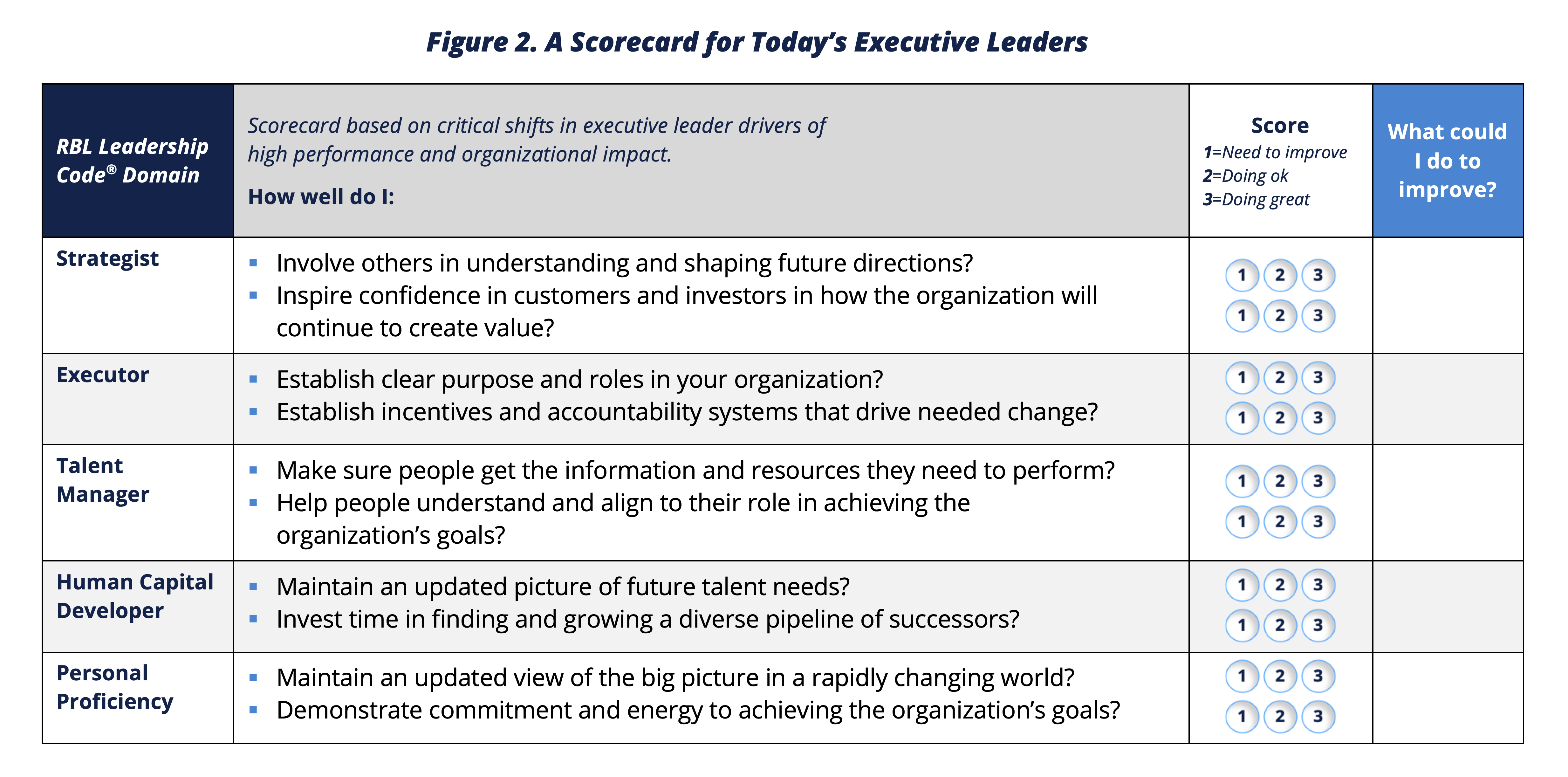New Expectations: Executive Leadership Behaviors That Create Organizational Value
Key Takeaways:
- The quality of executive leadership represents an average of 15% of an organization’s overall market valuation.
- Executives must still be able to set a customer-and investor-centric future direction and build the capabilities needed to get there.
- To create value, today’s executives must also excel at solving complex problems, evaluating alternative pathways, and engaging others to surface the right issues, find the best solutions and create commitment and buy-in.

New Expectations: Executive Leadership Behaviors That Create Organizational Value

Related Insights
In recent decades, empirical studies have provided growing evidence connecting what investors and other internal and external stakeholders have assumed for decades: companies with better executive leaders have better performance and higher valuation.i
Executives are responsible for making and delivering on promises their company has made in the near term to investors, customers, and other internal and external stakeholders. They cannot, however, be consumed by this (thus the importance of mid-level leaders). They must also look into the future and make decisions about how to use and grow their company’s current capabilities so that they remain competitive in the future.
The disruptions of the last five years have increased the pressure on executives globally. They have faced increasingly challenging questions about how to balance today’s promises with the work of anticipating and building the capabilities that will be needed for the future—even as that future seems to come faster and faster and become more and more ambiguous.
As we looked at data gathered over the last fifteen years, we wanted to understand what are the specific skills and behaviors that companies should invest in if they want to improve the executive leadership skills that influence strong organizational outcomes.
To help, we turned to our database of more than 2.2 million leadership-behavior ratings from 2009-2023. We analyzed 161,525 ratings of executive leaders from the periods of 2015-2019 (pre-COVID) and 2021-2023 (post-COVID). Each leader in the database was evaluated by their manager, peers, and direct reports on 67 leadership behaviors drawn from five research-based leadership domains (Strategist, Executor, Human Capital Developer, Talent Manager, and Personal Proficiency) in the RBL Leadership Code® as well as four outcome measures weighting each leader’s organizational value contribution.
How have expectations of executive leaders shifted?
The table below identifies key shifts: what is still important, as well as what is more and less important, for today’s executive leaders who want to deliver strong value for their organizations (Figure 1).

Executive Leadership Behaviors That Create Organizational Value
What’s the same post-COVID?
When we work with executive leaders we often tell them they have two key responsibilities. First, they need to work together to set a future direction that resonates with customers and investors. Second, they need to make sure the organization is reinforcing and building the capabilities that will be needed to deliver on promises—today and tomorrow. When we looked at the data, it told the same story.
To create value, our data show that today’s executives must excel at creating a customer-focused strategy that resonates with investors. They need to understand the organization’s strengths and how to leverage them today and tomorrow in ways that create value for and inspire confidence in customers and investors. And they need to be able to tell the story in a way that generates passion and confidence with stakeholders inside and outside the organization.
The data also indicates that today’s executives still need to focus on activating the human capability of the organization. To do that they must first establish clear purpose and roles that are aligned to the work and direction of the organization. Clear roles and effective communication help everyone understand their role in achieving organizational goals and drives productivity and engagement. At the same time, since these goals are usually aspirational, executives must also proactively define the knowledge and skills needed to be able to meet those goals while at the same time helping people close the gaps that matter most.
What’s different post-COVID?
While some of what has mattered for executive leadership effectiveness remains the same, there are some important and significant emerging expectations. Three of the four behaviors identified as more important now stand out as critical and mutually reinforcing when considering today’s environment: staying focused on the big picture, engaging others in the organization around future direction, and having personal energy and commitment.
The mental models and the passion required to engage in the challenging work of building a credible future direction and making day-to-day decisions in today’s world is more challenging than it has been in decades, if not centuries. A robust outside-in understanding is critical in a world where relying on past projections is almost impossible. The established world order and economic models seem tenuous at best; we appear to be entering into the next technological revolution, and many are still recovering physically and emotionally from the COVID pandemic.
Additionally, employees, customers, and investors expect a future direction that is meaningful and values-based in ways that are different than they have been in the past. Environmental impacts, geo-political tensions, equity and inclusion, individual wellbeing are all trends that remain important both to employees and to customers and investors and require a big picture orientation and more collaborative approach to decision-making.
To successfully navigate the uncertainty of today’s world and the expectations of today’s customers, investors, and employees requires
- commitment and energy to engage in the complexity,
- the ability to see the broad implications of alternative pathways, and
- the ability to engage others to surface the right issues, find the best solutions and create commitment and buy-in.
These three executive behaviors reinforce and enable one another in important ways in today’s world.
This is even more strongly reflected in the data from their managers which indicate that today’s C-Suite leaders prioritize driving change, seeking information from a variety of sources, and a constant focus on improvement in their executive teams.
In parallel to the work described above, it is more important than ever for today’s executives to factor in changing talent needs and understand and invest in building the talent that will be needed for the future.
Growing Today’s Executive Leaders
The scope and scale of the impact that leadership strengths and weaknesses in executives have on the organization and its short- and long-term success make investing in executive development critically important.
Evaluate how you are doing on today’s most critical executive leader behaviors with the self-assessment in Figure 2. If you are a C-Suite leader who leads executives or an HR business partner who supports them, this research can be used to help guide your efforts:
If you are a C-Suite leader who leads executives or an HR business partner who supports them, this research can be used to help guide your efforts:
- Create space for greater collaboration to foster outside-in strategic thinking: Engage with direct reports about external trends and their implications for the organization and share select information with them, perhaps even asking them to respond with their thoughts about how it might impact the organization. Create meaningful space for robust exploration and debate about how the external environment is shaping the future and how the organization might respond. Avoid the temptation to focus leadership meetings on monitoring execution of annual goals and provide adequate time and focus on collaboration and information sharing (customer, other external trends, inter-organizational).
- Link discussion of future directions with conversations about what the talent implications of that direction are: Establish and strengthen formal and informal processes to identify emerging skills and identify and/or grow people with skills or interest to develop those emerging skills. In parallel, ensure there is adequate budget to invest in growing emerging skills throughout the organization. Invest time and money in talent planning and provide simple talent planning processes that drive talent outcomes.
- Grow skills in communicating strategic direction with executive development programs: The ability to articulate a future direction clearly and consistently and in a way that resonates with a wide variety of audiences is a critical executive skill that is hard to develop “along the way.” Communication strategies for today’s values-based audiences can be effectively taught in group settings and can also allow executives to test and align on the organization’s future direction.
- Provide executive coaching to tailor executive development to the specific needs of each executive. Supported by assessments that surface areas of focus, growing self-awareness and deliberate focused investment in behavior changes can have significant impact at the executive level.
We believe this research provides important, data-based insights on how to build executive leaders that will deliver exceptional value to employees, customers, investors, and communities. The work executives do to define a future direction and build the capabilities needed to get there cannot be done at other levels of the organization. A strong cadre of executive leaders with the skills needed for today’s world can help ensure your organization’s long-term success.
Download a PDF summary of this research here. For more executive leadership research insights, click here. For similar research on first-line leaders, click here and for similar research on mid-level leaders, click here.
To discuss how this research can help you build an evidence-based leadership brand that increases value for your stakeholders, contact us to be connected with our leadership development experts.
i See Ulrich, D., Smallwood, N, and Ulrich, M. (2012) The leadership gap. CFA Magazine, Volume 23, No. 1, January – February 2012, 8-10. https://www.researchgate.net/publication/275884088_The_Leadership_Gap, The Financial Impact of Executive Leadership, CIO Journal, https://deloitte.wsj.com/cio/the-financial-impact-of-executive-leadership-01671242635, and Day, D. V., & Lord, R. G. (1988). Executive Leadership and Organizational Performance: Suggestions for a New Theory and Methodology. Journal of Management, 14(3), 453-464. https://doi.org/10.1177/014920638801400308.

